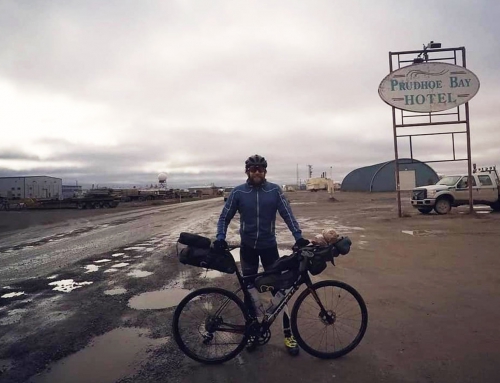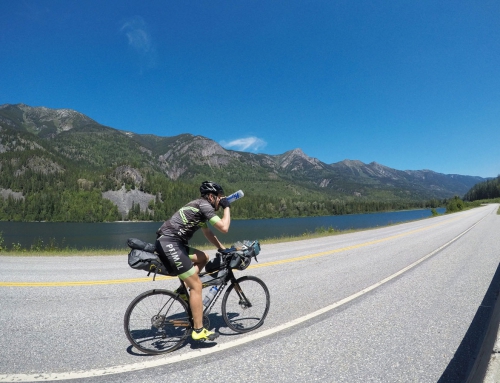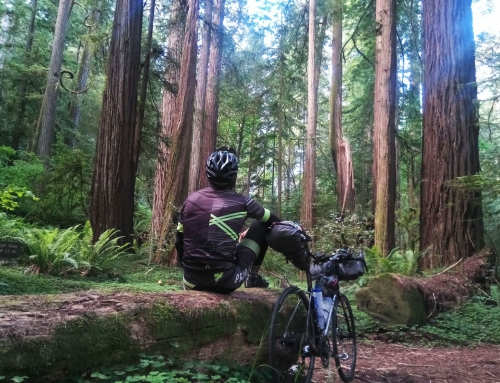Last week I cycled a day without luggage after bikepacking for two months which reminded me how much faster it is.
The supported cyclist is followed by a support car and has a crew that basically does everything apart from pedalling for him or her while the unsupported rider is a wild adventurer that faces many more challenges than pushing the bike.
The most recent supported around the world record reportedly cost more than 500.000 Euros, while most unsupported riders survive on 10-15 Euros a day.
Although these are two completely different concepts, they quite often get mixed up and compared. Time for some transparency:
The bike
Supported rider: Uses a 7 kg bike and changes between an aero and a mountain setup depending on the requirements of the terrain.
Unsupported rider: Uses one bike and carries all his luggage. 13-16 kg depending on food.
The food
Supported rider: has a cook that constantly prepares his favorite food, goes shopping and has an unlimited supply of energy and protein bars.
Unsupported rider: looses around two hours a day for shopping and cooking. Only has the food he finds daily which quite often is junk food and cookies.
The night
Supported rider: gets into his campervan or is driven to the next hotel and back to the point where he had stopped in the morning. Also enjoys a massage every night.
Unsupported rider: usually wild camps next to the road. Looses time with setting up a tent and often gets little comfort.
The distance
Supported rider: has a team that navigates for him and never has to take detours.
Unsupported rider: will eventually get lost and takes detours to hunt for food and supply. This will add up to several hundred kilometers extra.
The repairs
Supported rider: has a mechanic and all spare parts in the support car. Any mechanical issue will cost him just a few seconds to fix.
Unsupported rider: will loose time with bike maintenance every day and might get into big trouble when sth. happens with the bike. During my Eurasia record I lost several days just because of bike issues in the middle of nowhere.
Social media and filming
Supported rider: has a photographer and probably won’t do a single post during the challenge
Unsupported rider: takes pictures, shoots videos, interacts with media and updates social media. I calculate at least half an hour for this every day.
Unforeseen challenges
Supported rider: there are no or very few unforeseen challenges and then the support crew will take care of it.
Unsupported rider: will eventually get into some unforeseen trouble, that can cost days or hours. Sees this as part of an adventure.
Mental challenges
Supported rider: has a team to give mental support when it is tough
Unsupported rider: deals with the up and down on his own
The resources
Supported rider: spends anywhere between 50.000 and far more than 100.000 Euro for a several week long cycling tour due to vehicle and support crew.
Unsupported rider: spends between 10 and 15 euro per day plus flights and equipment.
This puts the supported ride at a budget of around 15-30 times the cost of an unsupported. The cost of a supported ride also excludes 99% of all endurance cyclists from trying it.
The skills
Supported rider: has to pedal strong and many hours but that’s pretty much it. Everything else is taken care of.
Unsupported rider: apart from pedalling, he or she has to navigate, improvise, film, motivate himself and do everything that an adventure requires. A broad set of skills is required.
The purpose
Supported rider: do it the fastest way possible is everything that counts.
Unsupported rider: usually, the journey and adventure is the main purpose. He or she wants to experience nature and interacts with locals. The record or title is the extra.
The statistics
Supported rider: Top athletes average around 700 km per day on week long challenges and 400-600 km on longer rides.
Unsupported rider: the best average around 350-400 on week long rides and 200-280 on longer challenges.
Conclusion
The supported rider can cycle several hours more every day and has a big advantage in basically everything. Comparing record times or races like the supported RAAM and the unsupported Transcontinental, supported athletes are around 40-50 % faster.
They are just two completely different concepts and comparing them is like putting a mountainbiker against a road cyclist. A supported ride is a great athletic achievement but it has little to do with an adventure while the unsupported cyclist is an adventurer and consciously accepts not doing it the fastest time possible.
Of course both have its purpose but it should be made very clear what resources are used during a challenge. Sadly there are no clear guidelines that define what is allowed and there have even been record attempts that were pursued in the wind shadow of the support car or with a constant change between a time trial and road bike, giving the rider even a massive advantage over other supported riders.
For me cross continent cycling is about adventure, pushing myself to the limit and somehow making it against all odds very fast to the finishing line. I will be fully unsupported, always.



